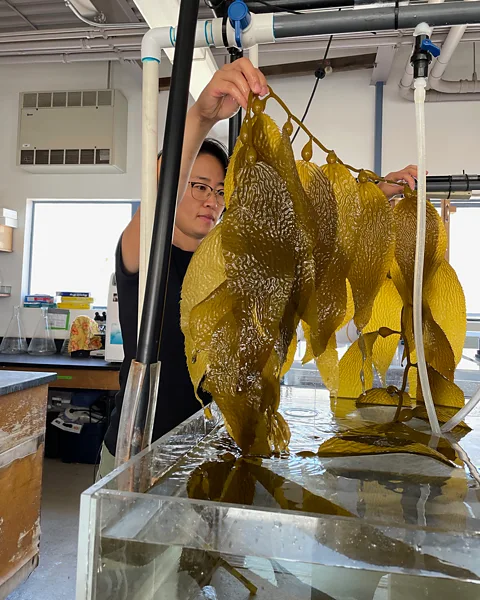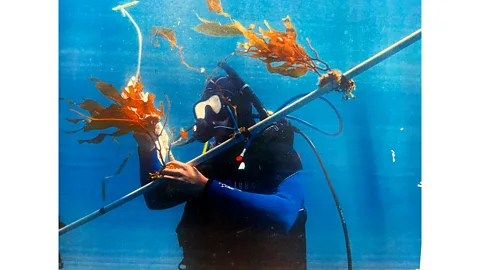
Features correspondent
 BBC
BBCIn the shallow waters near the ocean shore, giant kelp grows in dense clusters. Much like a forest on land, the thick blades of algae provide food and shelter to thousands of animals and plants.
A root-like structure anchors each strand to rocks on the seabed while gas trapped in the blades – which can reach up to 30m (100ft) long – allow them to rise vertically in the water. Near the surface, the kelp forms a dense canopy wafted by currents and waves.
It is not the first place you might look to find the future of flying. But that is exactly what these tranquil underwater forests could be – a solution to the aviation industry’s significant carbon emissions problem.
While small prototypes of electric aircraft – and even a few solar powered planes – have shown some promise, they are unlikely to become the workhorses of the industry that carry passengers and cargo around the world. Instead, in the short term at least, aircraft will need to be powered by jet fuel that doesn’t add carbon to the atmosphere.
It’s this rapid growth that allows kelp to lock large amounts of carbon away within its stripe and fronds – the algal equivalent of a trunk and leaves.
2045: Memories of the Future
This article is part of 2045: Memories of the Future, a multimedia series by BBC Future and BBC World News that examines how much the world will have to change by the year 2045 if it is to reach net zero by the middle of the Century and so keep climate change to within the 1.5C target set by the Paris Agreement on Climate Change.
But seaweed can also be harvested and turned into biofuel. Although when burned, it will still release greenhouse gases into the atmosphere, as the fuel is made with carbon already drawn from the air by the algae, it shouldn’t contribute additional emissions. In an added bonus, giant kelp forests can support other marine life that also help remove additional carbon from the atmosphere and some analyses estimate using macroalgaes for biofuels could even be carbon negative overall in the right conditions, although this has still to be thoroughly tested in practice.
Corinne Scown, deputy director of the energy analysis and environmental impacts division at Lawrence Berkeley National Laboratory in the US, says the changes required to accommodate bio-jet fuels at airports and in planes, are minimal compared to what’s needed to electrify aviation.
“One of the big advantages of this (bio fuel from kelp) is that it can use all the existing refining infrastructure of the petrochemical industry,” adds Brian Wilcox, the co-founder and chief engineer at California-based company Marine BioEnergy, which has been working with scientists to develop kelp-based biofuels. “It in many cases looks like crude oil and it goes through the same processes.”
The problem for the aviation industry, however, is how to raise sufficient quantities of the high-quality fuel needed for its aircraft.
 Diane Kim
Diane KimResearchers at the Wrigley Institute for Environmental Studies on Santa Catalina Island working with Marine BioEnergy are developing what they hope could be a solution that would allow large scale kelp farming that could be used for biofuel.
Their idea hinges around a set of experiments they conducted as part of a US Department of Energy-funded research programme that called for novel sources of energy from algae. Kim and her team collected two sets of kelp from its underwater habitat off the coast of Santa Catalina Island, California. Forty of the kelp strands were attached to a long line at a depth of 10m (33ft) near the kelp’s original habitat. Another 40 were fixed to a boom that could move to varying depths like an elevator. For the first 100 days, this set was submerged at a depth of 80m (263ft) during night. During daytime, they lifted it close to the ocean surface to absorb sunlight.
After the experiment, the depth-cycled kelp had yielded almost four times as much biomass as the set kept at the shallower depth closer to its natural habitat. In addition, the depth-cycled algae grew far faster – at 5% per day against 3.5% for the set in the natural habitat. This is because while kelp needs sunlight to grow, it also needs nutrients, which are more abundant further from the surface where light is weaker.
“Any nutrients that are introduced to the surface waters get taken up by phytoplankton quite rapidly,” explains Diane Kim, a marine ecologist at the University of Southern California who was one of the researchers on the study. “The surface of the ocean is very nutrient limited.”
Kim and her colleagues believe this depth-cycling represents a promising option for biofuel generation as it allows kelp to take advantage of both the sunlight closer to the surface and the higher nutrients further down in the water column. Using methods like this could allow kelp to be farmed for biofuel, which would be attractive as it doesn’t compete with food production, unlike other sources such as corn, soy beans and palm oil.
Wilcox, who has been working with Kim, claims it would only require 0.5% of the Earth’s oceans to be used for cultivating seaweed in order for kelp-based bioenergy can replace liquid fuels for all long-haul vehicles and planes worldwide. In 2013, an estimated 4% of global agricultural land was being used to grow biofuels – a figure that is likely to have grown since then as demand has increased.
“Oceans are twice as big as the land,” says Wilcox. “Kelp is easy to process into carbon-neutral fuels because it has no lignin and little cellulose. It can be harvested after each 90 days without killing it.”
Several methods for converting kelp into biofuels have already been explored, including a process called hydrothermal liquefaction. This involves extraction of biocrude oils by breaking down the solid carbohydrate-rich biomass into liquid components in hot pressurised water.
Kim believes that if kelp can be grown on large scale oceanic farms, it could provide a cheap source of fuel. She says an added bonus of using kelp is that it doesn’t need fertilisers or pesticides to grow.”The reason depth-cycling is important is that it empowers us to grow millions of tons of kelp by towing farms in the open sea with unmanned drone submarines,” says Cindy Wilcox, co-founder and president of Marine BioEnergy.
 Heritage Space/Getty Images
Heritage Space/Getty ImagesThomas Brück, a professor of synthetic biotechnology at the AlgaeTec Center at Technische Universität München, Germany, is trying to grow algae that thrives in high salt environments for biofuel. He and his team, who are collaborating with Airbus on the project, have identified a microalgae called Picochlorum renovo that grows extremely quickly in a range of salt and temperature conditions. But Brück believes they may be able to enhance its tolerance of high salt conditions further with the help of genetic engineering.
This would allow the algae to be grown in environments that are too inhospitable for food production or other types of agriculture. Brück and his team run a demonstration centre where they have cultivated this algae and believe its potential could be huge.
“We can provide between 40-50% of aviation fuel in seven years if we start today,” Brück says.
Unlike kelp, however, this approach will require new refineries and distribution systems, and financing remains a major hurdle for the concept. For this to work, Brück says governments, for example in Europe, need to invest in the algae cultivation technologies and build at least one refinery to get the concept off the ground. This, he explains, would make the business look less risky and attract the private sector – which will be key to its success.
“We are talking about a refinery in the order of €200m-300m (£168m-252m). If you want to cultivate algae on 100-200ha (247-494 acres), you need the same figure (refinery cost). No investor will do it if there’s the tiniest doubt about return on investment,” Brück argues.
Massimiliano Materazzi, a chemical engineer at UCL who is leading the team, says if things go as planned, a demonstration plant could be ready by 2023 and sustainable aviation fuels made from waste could start being used by 2025.
“The UK sends 15 million tons of waste to landfills yearly – these can meet 40-50% of aviation fuel,” Materazzi says.
While currently the main focus is to produce jet fuels that are similar to those currently in use, another option is to use waste to produce hydrogen. Materazzi believes this can be done by producing biogas from the waste and then using that to produce hydrogen. Another more direct route being explored by other researchers, however, is to obtain hydrogen from waste through dark fermentation. This is a biological pathway that involves the use of microorganisms to breakdown waste into biohydrogen.
 ZeroAvia
ZeroAviaThere have already been a couple of test flights of small fully-electric planes capable of carrying a few passengers. But currently hydrogen and electric planes seem unlikely to be capable of carrying large passenger numbers needed by the major commercial airlines nor be able to cover the long distance flights, says Scown. The heavy batteries and their limited capacity means electric planes may remain limited to short-haul flights by small aircraft.
Ultimately, however, Scown says all these technologies will be needed to if we are to continuing flying without adding to the climate change crisis, but the scale of the challenge is still immense.




